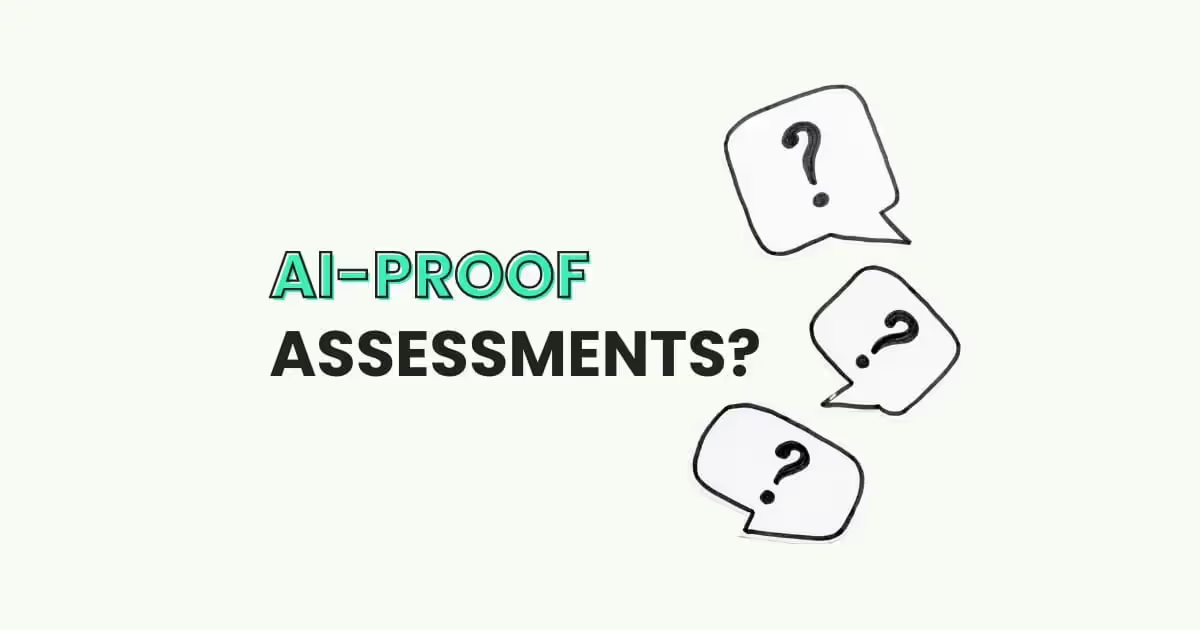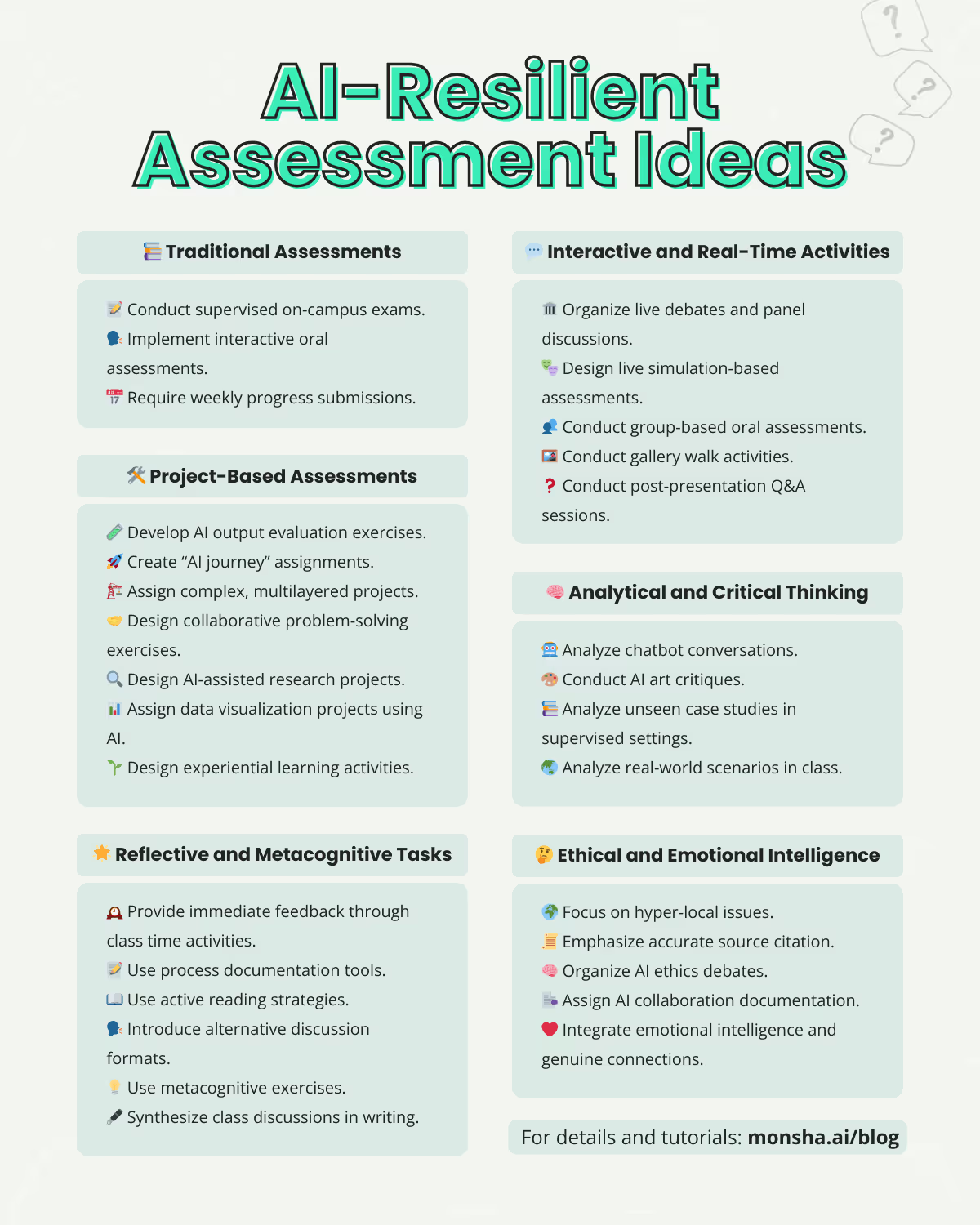Strategies, ideas and examples for designing ChatGPT and AI-proof assignments and assessments that promote critical thinking, creativity, and human interaction among students.

In the age of rapidly advancing generative AI, educators face a pivotal question: How do we design assessments that both embrace AI and ensure authentic learning? As the line between human and AI-generated work blurs, we're challenged to rethink our approach to evaluation.
But what if this challenge is actually an opportunity?
What if we could create assessments that students genuinely want to engage with?
To answer these questions, we've curated a list of 30 innovative assessment ideas. Each idea offers a fresh perspective on evaluation in the digital age. Whether you're looking to AI-proof your assignments or embrace AI as a teaching tool, you'll find inspiration in the following list. Plus, don't miss the beautifully designed, shareable infographic at the end of this article.

Supervised on-campus exams ensure academic integrity while testing higher-order thinking skills. You should design these exams as open-book tests that emphasize application and analysis over rote recall. For instance, in a music listening exam, you could ask students to analyze and critique unfamiliar compositions, test their ability to apply theoretical knowledge to new contexts.
To implement this you can prepare a combination of standard and follow-up questions for 10-15 minute assessments. For example, simulate a client meeting where students present and defend a marketing strategy. This way students can articulate their knowledge and respond to dynamic questioning.
Keep taking frequent, low-stakes assessments. Conduct brief quizzes or drafting exercises during class time, followed by immediate peer or tutor feedback. Maybe start each tutorial with a 10-minute quiz, which is then reviewed collectively as a class. This approach helps reinforce understanding and provides instant feedback. And since the stakes are lower, students are less likely to resort to using AI.
For example, host a class debate on current ethical issues in the field, with students rotating as speakers and engaging in rebuttals. Assign roles to students in advance and provide clear grading criteria for participation. This format not only evaluates students' ability to argue and defend their viewpoints but also encourages active engagement and dynamic learning.

Regular progress submissions help track ongoing work, discourage last-minute cramming, and encourage iterative learning. Set up a system for students to submit their work-in-progress regularly and provide quick feedback. For example, in a science course, students can submit weekly lab reports, and instructors can give comments to guide their next steps.
Engage students with immediate, relevant topics that may be beyond AI's knowledge base by assigning research or projects related to local community issues. For example, students could conduct and analyze surveys on campus sustainability practices.
Develop detailed scenarios and, if necessary, train facilitators or actors. An example is a crisis management simulation for public relations students, where they respond to evolving situations, and demonstrate their problem-solving and critical thinking skills in real-time.
Encourage consistent effort and verify student work over time by utilizing document editing tools with version history features. For example, students can submit assignments through Google Docs with version history enabled.
Being able to assess and edit AI-generated content is now more important than ever. Provide AI-written essays for students to review, identify strengths, weaknesses, and biases. This practice enhances their ability to critically evaluate AI outputs and makes them more conscious of not writing like AI
Encourage thoughtful integration of AI tools in complex tasks. Assign a performance task where students use AI tools and document their process. For example, students can create a multimedia presentation, detailing and justifying their choice and use of AI tools throughout the project.
Engage students in understanding AI communication by having them interact with and analyze responses from various chatbots like ChatGPT, Gemini, Claude, or Copilot. Students could compare how different AI assistants respond to the same set of questions, highlighting differences in accuracy, tone, and usefulness.
Foster critical thinking by comparing AI-generated art with human-created pieces. Provide students with examples of both and have them analyze the creativity, technique, and emotional impact. For example, students can compare an AI-generated painting (by Midjourney or ChatGPT for instances) to a similar work by a human artist, discussing the strengths and weaknesses of each.

This method evaluates students' ability to apply theoretical knowledge to new situations in real-time. In a controlled environment, students receive case materials and the necessary resources. For example, marketing students could analyze a new product launch strategy during a timed, in-class session. This approach ensures that students independently demonstrate their understanding and problem-solving skills, free from external assistance. It also encourages quick thinking and effective application of learned concepts in practical scenarios.
Try designing projects with interrelated tasks that build over time. In a business class for instance, you could assign a semester-long project where students develop a business plan, starting with market research and culminating in a final pitch. This scaffolds learning and allows for comprehensive understanding and application of course material.
Teach students effective annotation techniques and utilize collaborative annotation tools. For instance, students can use Hypothes.is to collectively annotate and discuss a scientific paper, enhancing their understanding through shared insights.
Traditional discussion boards can be supplemented with more dynamic interaction methods. You could implement live chat tools or digital whiteboards for synchronous discussions. An example would be a scheduled chat session where students collaboratively solve a complex problem, promoting immediate and engaging interactions.

Develop students' awareness of their thought processes and learning strategies by integrating reflection exercises into existing assignments and class activities. For example, have students write a reflection on their problem-solving process after completing a task.
Develop exercises that build teamwork skills and the ability to tackle complex, multifaceted problems. Design group projects requiring diverse skills and knowledge integration. For instance, interdisciplinary student teams can develop solutions for sustainable urban planning, drawing on expertise from fields like environmental science, engineering, and urban studies. This approach not only fosters collaboration but also encourages students to think critically and creatively about real-world issues.
Combining individual and group assessments encourages peer learning and collaboration. For group-based interactive oral assessments, mark the students' written work beforehand, and prepare the key questions for oral follow-up. Brief the students on potential topics and engage in a facilitated group discussion. You should moderate the conversation, posing questions to one student and allowing others to contribute follow-up responses or questions.
To develop strong research skills and ensure students engage with credible sources, emphasize accurate citation practices. Require students to include in-text citations and a reference list in their assignments. For added rigor, verify the accuracy of these citations. For example, have students submit an annotated bibliography alongside their research paper, detailing the relevance and reliability of each source. This practice not only reinforces the importance of academic integrity but also enhances students' ability to discern and use legitimate sources effectively.
Encourage active engagement and peer learning by setting up stations with various topics or questions for students to explore. For example, students can rotate through different stations analyzing historical documents. You can get creative here.

Promote the application of knowledge to current, unexplored situations by presenting new scenarios for analysis. Afterward, students can visually represent their findings. For instance, they might analyze a breaking news event and create infographics to illustrate their insights and conclusions.
Encourage active participation and the integration of peer perspectives by requiring written assignments that incorporate insights from class discussions. Students might write an essay that references specific points raised during a class debate, for instance.
Integrate AI tools into the research process while maintaining critical thinking. Guide students in using AI for specific research tasks and evaluating outputs. For instance, students can use AI to summarize articles and then critically evaluate and expand on these summaries.
Promote understanding of AI capabilities and limitations through direct experience. Have students use and document specific AI tools in their assignments. For example, students might use an AI writing assistant and reflect on how it influenced their writing process.
Promoting critical thinking about the societal and ethical implications of AI can be achieved by organizing structured debates. For instance, students could debate the ethical considerations of using AI in criminal justice decisions.
Developing skills in using AI for data analysis and effective visual communication is essential. You can guide students in analyzing and visualizing large datasets with AI tools. For example, students could analyze climate data and create interactive visualizations, enhancing their analytical and presentation skills.
Providing hands-on experience by applying course concepts to real-world situations still remains invaluable. Organize field trips, service learning, or community-based research projects. For example, biology students might conduct a local ecosystem survey and present their findings to the city council, bridging theoretical knowledge with practical application.
Prepare probing questions and encourage audience participation. Post-presentation Q&A sessions verify a student's deep understanding of their material and their ability to think on their feet.
What we humans have that AI doesn't are emotional intelligence and genuine connections. Let's leverage these strengths to create meaningful assessments, promote critical thinking and human interaction!


AI for Teachers
We’re the Monsha Team—a group of educators, engineers, and designers building tools to help teachers combat burnout and get back to life.. Our blogs reflect real classroom needs, drawn from conversations with educators around the world and our own journey building Monsha.
Join thousands of educators who use Monsha to plan courses, design units, build lessons, and create classroom-ready materials faster. Monsha brings AI-powered curriculum planning and resource creation into a simple workflow for teachers and schools.
Get started for free